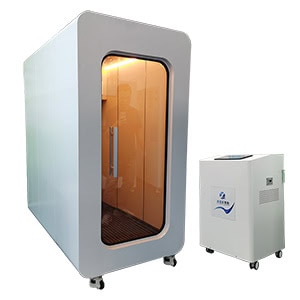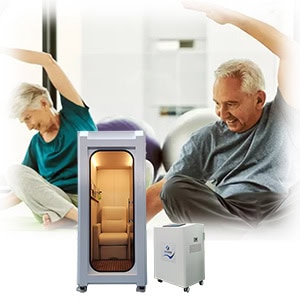What are the Benefits of a Hyperbaric Oxygen Chamber
Introduction
Hyperbaric oxygen therapy (HBOT) offers a myriad of benefits for various medical conditions by leveraging the power of oxygen in a pressurized environment. This advanced therapy involves patients breathing pure oxygen inside a hyperbaric chamber, where the atmospheric pressure is increased to levels significantly higher than normal. The primary advantage of this approach is the enhanced delivery of oxygen to the body’s tissues, which can significantly boost healing and recovery processes. HBOT is recognized for its effectiveness in treating a wide range of ailments, from chronic wounds and serious infections to decompression sickness and radiation injuries. This article will explore the numerous benefits of hyperbaric oxygen therapy, detailing how it works and the diverse medical conditions it can address.
Increased Oxygen Delivery
Inside a hyperbaric chamber, the air pressure is elevated, enabling your lungs to absorb significantly more oxygen than under normal conditions. This heightened oxygen absorption is due to the increased atmospheric pressure, which allows a larger volume of oxygen to dissolve into your bloodstream. The oxygen-rich blood is then distributed throughout your body, delivering this essential element to various tissues and cells. This process is particularly beneficial for areas that may be deprived of adequate oxygen, such as those affected by injuries, infections, or chronic medical conditions. By enhancing the oxygen supply to these tissues, hyperbaric oxygen therapy (HBOT) supports cellular metabolism, aids in tissue repair, and improves overall physiological function.
Reduced Swelling and Inflammation
The elevated oxygen levels provided by hyperbaric oxygen therapy play a crucial role in reducing swelling and inflammation in the body. When tissues are injured or infected, inflammation is a natural response, but it can sometimes become excessive and impede the healing process. HBOT helps mitigate this by supplying high levels of oxygen, which can reduce the inflammatory response and promote more efficient healing. The oxygen aids in minimizing the swelling and accelerates the recovery of damaged tissues. This therapeutic approach is especially beneficial for conditions where inflammation is a significant component, contributing to quicker and more effective recovery.
Improved Wound Healing
Hyperbaric oxygen therapy is highly effective in enhancing wound healing, particularly for wounds that are slow to heal on their own, such as diabetic foot ulcers. The increased oxygen levels stimulate the growth of new blood vessels, a process known as angiogenesis, which improves blood flow to the affected area. Additionally, HBOT promotes the regeneration of skin and other tissues, facilitating faster and more complete healing. This therapy is valuable for patients with chronic wounds or those that have become resistant to conventional treatments, providing a powerful adjunctive option to support the body’s natural healing mechanisms.
Treatment of Infections
The high oxygen levels within a hyperbaric chamber are effective in combating certain types of bacteria and enhancing the body’s immune response. Some bacteria, particularly anaerobic bacteria, thrive in low-oxygen environments and can cause serious infections. By increasing the oxygen concentration in tissues, HBOT helps inhibit the growth of these bacteria and supports the body’s ability to fight off infections. Additionally, the therapy boosts the activity of white blood cells, which are crucial for immune defense. This makes HBOT a valuable treatment option for serious infections that are resistant to antibiotics or other standard treatments.
Decompression Sickness Treatment
Hyperbaric oxygen therapy is a well-established treatment for decompression sickness, a condition that can occur in scuba divers who ascend too quickly. Decompression sickness is caused by nitrogen bubbles forming in the bloodstream and tissues due to rapid pressure changes. The increased pressure within a hyperbaric chamber helps to reduce the size of these nitrogen bubbles and facilitates their removal from the body. This process alleviates the symptoms of decompression sickness and prevents potential complications. HBOT is considered the gold standard for treating this condition and is commonly used in dive medicine to ensure the safety and recovery of divers.
Radiation Injury Treatment
Hyperbaric oxygen therapy can effectively treat tissue damage caused by radiation therapy, which is often used in cancer treatments. Radiation can cause significant harm to healthy tissues, leading to a condition known as radiation-induced injury. HBOT helps to mitigate these effects by increasing oxygen supply to the damaged tissues, promoting healing and regeneration. The therapy stimulates the growth of new blood vessels, enhances tissue oxygenation, and reduces inflammation, all of which contribute to the recovery of radiation-damaged tissues. This makes HBOT a valuable adjunctive treatment for patients who have undergone radiation therapy and are experiencing adverse side effects.
Improved Circulation
Hyperbaric oxygen therapy can significantly enhance blood flow and circulation, which is beneficial for conditions such as peripheral artery disease. By increasing the oxygen levels in the bloodstream, HBOT promotes the dilation of blood vessels and improves overall vascular function. This improved circulation ensures that more oxygen and nutrients are delivered to tissues, supporting their health and functionality. For patients with conditions that impair blood flow, such as diabetes or cardiovascular diseases, HBOT can provide a critical boost to their circulatory health, aiding in the prevention and treatment of complications related to poor circulation.
Conclusion
In summary, hyperbaric oxygen therapy is a valuable medical treatment that enhances oxygen delivery to tissues, promoting healing and recovery across a variety of conditions. From reducing inflammation and improving wound healing to treating serious infections and radiation injuries, HBOT offers numerous therapeutic benefits. It is particularly effective for conditions where oxygen deprivation or impaired circulation is a concern. However, it is essential that HBOT is administered under the supervision of a qualified healthcare provider to ensure its safety and effectiveness. This advanced therapy continues to be a vital tool in modern medicine, offering hope and healing to many patients.













